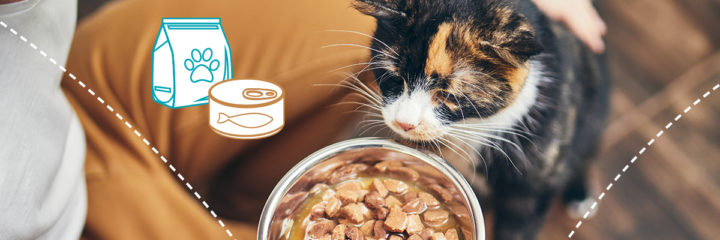
Summary
- Chronic kidney disease is clearly influenced by the feed
- If a cat eats too little protein, it will break down its own muscles
- Oral dialysis using uraemic toxin binders as a new alternative to dietary feed
Properly feeding a cat with chronic kidney disease demands a lot from the owner
Cat owners are not only stressed and guilted by the diagnosis of CKD itself, but also by feeding their beloved cat. This is mainly because the disease causes cats to lose their appetite, causing cat owners to despair. (see Rollercoaster of emotions )
Diet and disease are closely related
The disease is clearly influenced by the feed. This is the reason why dietary feeds are used in treatment of chronic kidney disease. One aspect is that the proteins contained in the feed (or rather their building blocks, the so-called amino acids) form uraemic toxinsToxic, nitrogen-containing urinary substances responsible for uraemia and kidney damage...., which promote the progression of CKD. This happens by destroying the nephronsNephrone sind die Filtereinheiten der Nieren.... with tissue remodeling of the kidneys and thus leading to clinical symptoms. This is called ‘gut-kidney axis’, as the natural microbiomeAll microbes on or within an animal’s tissues, for instance in the intestines (intenstinal flora = the totality of all microorganisms that colonise the intestine). It includes bacteria, protozoa, fungi and viruses.... of the intestine transforms the amino acids from proteins into toxic breakdown products and thus worsening chronic kidney disease.
Reduction of uraemic toxins
Protein reduction is aimed at in the chronic kidney diseased cat to reduce the uraemic toxins and thus slow down the progression of CKD and improve clinical symptoms. In addition, muscle meat, containing high quality proteins for the cat, is high in phosphate as well. (see THE DEVIL’S IN THE “P” )However, phosphate is also involved in the progression of CKD, so this should also be reduced. Phosphate reduction in dietetic foods is achieved by replacing muscle meat with plant-based proteins, which usually contain wheat gluten as a protein base. Kidney diets are additionally protein-reduced, too.
Cats need proteins in their feed
Cats as obligatory carnivores require a high protein level in their food, as their entire metabolism is based on the breakdown of proteins from which they predominantly derive energy. For the cat to consume enough energy and calories to maintain its weight and muscle mass, high protein levels in its food are a must.
In contrast to dogs, cats cannot form the essential, i.e. vital, amino acids themselves, but have to take them up with the feed protein (e.g. muscle meat or wheat gluten, whereby animal proteins have a higher biological value). In addition, cats love the taste of proteins and, if they had the choice, they would eat protein-rich food and eat smaller amounts between 12 – 20 times a day.

Eating right increases chances of survival
If a cat eats too little protein, it will decompose its own muscles. This releases creatinineCreatinine is a breakdown product of muscle metabolism. Its blood level is dependent, among many factors, on age, weight, nutritional status and muscle mass. Hence, creatinine levels in the blood vary from individual to individual. Creatinine is continuously excreted in the urine. Increased blood creatinine... (from the muscle metabolism) and thus increases the creatinine level in the blood. An elevated blood level of creatinine indicates a worse stage of CKD (see IRIS stages). In addition, the cat not only loses muscle mass (cachexia), but also weight. The survival rate of a cachectic or anorexic cat (= cats that do not eat) with CKD is much worse than in normal weight CKD cats. And starvation itself can also lead to another life-threatening disease: hepatic lipidosis (= acute fatty degeneration of the liver).
Therefore, a kidney diseased cat needs to eat, above everything else. If necessary, you must motivate the cat to eat, for example by giving the cat something on top of its food that it particularly enjoys. Some cats also like to eat eggs, whose protein has the highest biological value. Heated food is usually preferred by CKD cats because the heat increases the smell of the food, which the cat is more sensitive to.
Protein reduction dilemma
From the information given above it becomes clear that protein reduction is a quandary: During the course of CKD disease, people will try to lower creatinine levels and feed the cat with protein and phosphate reduced foods. This can be achieved with dietary food.
However, many cats do not like this food. And when cats eat poorly, the low protein intake and associated muscle loss “has a more negative effect on CKD than any food” (Sturgess, 2008). Even if cats eat at least part of their protein-reduced food per day, the muscle breakdown will still occur, since the amount of proteins contained is not sufficient.
It is therefore important that the cat eats at all. Cats would rather starve to death with a full bowl in front of them than eat something they don’t like. Starvation and its direct and indirect effects on the body is the most common cause of death or euthanasia in cats with chronic kidney disease (Polzin, 2007).

Sigh of relief with alternative approaches
It is therefore important that CKD sick cats eat at all. It would be good if cats would eat a food optimized for CKD, but if the cat refuses the dietary food altogether or eats irregularly, it is better to feed it the food it enjoys.
There are newer, alternative possibilities for cats who refuse the dietary food: by adding phosphate binders and so-called uraemic toxins binders, both of which can be sprinkled over the food. The uraemic toxin binder (the active ingredient is Renaltec®) is relatively new. It has the advantage of being odourless and tasteless, so that it is eaten well by cats when mixed into their beloved wet food.
Oral dialysis
The uraemic toxin binder acts like an oral dialysis by binding the uraemic toxins, produced during protein metabolism, as precursors in the intestine and then leaving the cat with the faeces. It can also be given in addition to dietary food, since CKD food must also contain essential amino acids. From essential amino acids, natural intestinal bacteria (intestinal microbiome) form degradation products such as the benamed precursors of uraemic toxins. If these precursors are adsorbed already in the intestine, they can no longer be transformed into uraemic toxins. The harmful effects of the uraemic toxins are thus reduced.
In people with chronic kidney disease, life prolongation and reduction of clinical symptoms has been achieved by reducing uraemic toxins using the uraemic toxin binder.
The veterinary product is a further development of the human product and differs from it by an even higher binding capacity for uraemic toxin precursors and is therefore even more potent and specific (Mottet, 2020).
Conclusion
The most valuable CKD food is the one the cat will eat. Diet food would be the way to go, but before the cat starves to death in front of a full bowl, it is better to give it the food it prefers or make the food more appealing again.
Food is essential for cats with chronic kidney disease.
Bibliography:
- Mottet, J. (2020): More than meets the eye, ISFM-Webinar, 21st October 2020, https://icatcare.org/event/isfm-webinar-free-access-uraemic-toxins-more-than-meets-the-eye/
- Polzin, D. J. (2007): 11 guidelines for conservatively treating chronic kidney disease In: Veterinary Medicine, 102, S. 788–799.
- Sturgess, K (2008): Nutrition Management of Renal Disease. WSAVA Congress, 20.-24.08. 2008, Dublin, Ireland.


